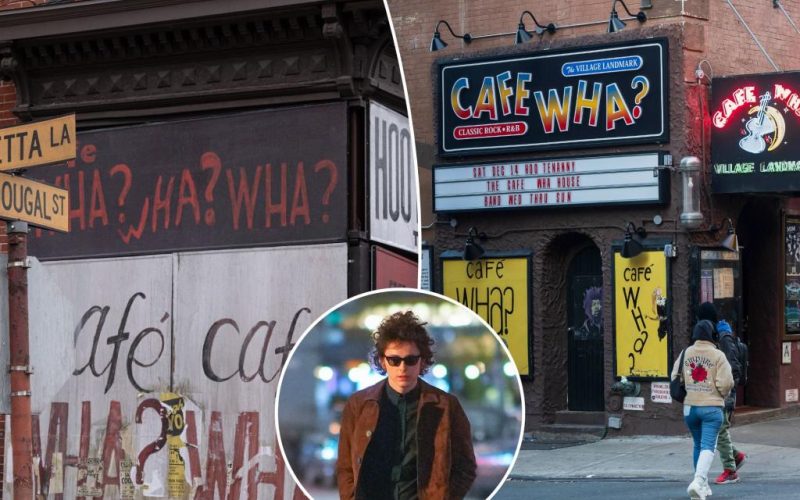The times they are a-changin’ — and so has the neighborhood.
For the new Bob Dylan biopic “A Complete Unknown,” starring Timothée Chalamet, production designer François Audouy was tasked with meticulously recreating the rock legend’s Greenwich Village haunts from more than 60 years ago.
But he faced a challenge. Even though some of those spots are still alive and kicking, downtown Manhattan looks nothing like it did back then.
“It’s missing the patina of New York in the 1960s,” Audouy told The Post. “But the other thing, though, is that it’s almost impossible to shoot a movie like this on a street where every business is going to ask for $1 million or $100,000 or more to allow the level of control that we need.”
So, director James Mangold shot most of “A Complete Unknown” — in theaters Dec. 25 — on-location in Jersey City and Hoboken, NJ, where he and Audouy could change whatever they pleased. Real buildings with character, even across the Hudson, were preferable to an artificial studio in LA, the designer said.
“When you’re in a business like a cafe or a restaurant and you’re looking out the windows, you’re not looking into a green screen. You’re looking at pedestrians walking by and cars going by,” he added. “That’s the movie that we were trying to make — something that was real and as grounded as possible.”
Here’s how “A Complete Unknown” nailed Bob Dylan’s New York City.
Dylan’s First Apartment
While creative liberties were taken with some sets, Dylan’s first NYC apartment on 161 West 4th Street, where he lived with girlfriend Suze Rotolo, was the most detail obsessed project. Sadly, although still standing, the genuine article was unusable.
“The interior has been unfortunately completely gutted,” Audouy said.
So, studying photos by Don Hunstein and never-before-seen negatives of Ted Russell, the team turned an apartment in Hoboken that was physically “very close” to the original into Dylan’s famous abode.
“We filled it with all of these details from the photographs, like his exact chair, the same handmade furniture, the same record player, the same typewriter,” the designer said. “We rebuilt his desks and his and all that.”
They also erected a fully functional kitchen. “The stove worked, you could make a coffee, you could wash the dishes, you could open the fridge, you could go to the bathroom, we could pour a bath,” he said.
The space was so realistic, in fact, that Chalamet often lounged around when not shooting to better transform into Dylan.
“Timmy would spend hours on the set just becoming familiar with the space,” Audouy said. “He basically had a time machine at his disposal to do whatever he wanted. He could go back to the 1960s and go to his apartment and hang out.”
Cafe Wha?
A 19-year-old Dylan first performed at Cafe Wha? at 115 MacDougal Street in 1961 soon after he arrived from Minnesota and he was still a nobody. Guitar in hand, he sang some Woody Guthrie songs to a rapturous response.
The music club has been chugging along since it was founded in 1959. However, so much of its West Village area is visibly different — for instance, Kettle of Fish bar has since moved to Christopher Street — that Audouy’s team was forced to rebuild the iconic facade on Jersey Ave. in Jersey City.
“The Jersey Hub,” Audouy called it.
“That corner was all based on research,” the designer said. “We built Cafe Bazaar across the street from it, which no longer exists… We had Cafe Figaro, which was an interior-exterior build, and Kettle of Fish.”
Gaslight
You can still visit the subterranean coffeehouse and folk music club where Dylan recorded “Live at the Gaslight 1962.” Sort of. The place closed its doors in 1971. Now, the establishment at 116 MacDougal is a cocktail bar called The Up & Up. Above it sits a tattoo parlor. So, Audouy had to build the biz.
He was more concerned with capturing a vibe, however, than delivering a picture-perfect replica.
“We wanted to have a Gaslight that felt like the Gaslight,” he said. “But then we had other sets that we actually decided to make as close as possible to the real thing, like Columbia Records and Bob’s apartment.”
To achieve the essential below-ground atmosphere, he found a legit basement in one city and fashioned an entrance in another one.
“We were shooting in an old Elks lodge on Washington in Hoboken that had great old bones and hadn’t been updated in… ever,” he said. “And in the basement, there was a really great bar that we turned into the Gaslight as closely as possible.”
The front, then, was set up at the Jersey Hub. The audience watches as Joan Baez (Monica Barbaro) descends the Gaslight steps to find Chalamet’s Dylan playing onstage.
“You’re seeing the sign and you’re getting a feeling for it,” Audouy said of the perfectly smooth transition from outdoor to indoor. “It’s not like we’re making a ‘Seinfeld’ episode.”








